After a merger or acquisition, the last thing you want is complications. Unfortunately, ERP systems like Oracle EBS don’t always cooperate. So when a large corperation hit a snag integrating a newly-acquired company into their Oracle EBS environment, they called Lighthouse to make big changes in a change-averse environment.

Photo courtesy of DG EMPL (Creative Commons)
What happens when you acquire a multimillion-dollar company and you can’t invoice their customers automatically?
You do it by hand. And it’s a time-consuming, revenue-wasting pain in the neck.
So when an enterprise-level company discovered that their new business was invoicing their customers manually, they saw a relatively straightforward and risk-averse remedy—integrating their service-contracts billing into their Oracle EBS system. But, due to the annual billing process (a flat rate for the entire year) their Service Contracts module had been set up for, the newly-acquired company’s usage-based billing process (invoicing based on transactions processed) was incompatible with their Oracle EBS environment. Desiring a swift, efficient resolution, Lighthouse was brought in to successfully integrate the newly-acquired company’s billing process and eliminate any opportunities that could lead to missed revenue.
From the outset, Lighthouse had a clear solution in mind—integrating the new business’s invoicing within Oracle Usage Contracts—so their first step was to work with the client’s business team lead in defining requirements and developing prototypes to convince the client’s management. Upon securing their buy-in, the team set about developing business solutions and processes; looking for ways to minimize counters within the Service Contract module and eliminating the need to load the installed base by adding counters prior to building the contract itself.
To support the invoicing process, Lighthouse defined and set up usage items within Oracle Inventory and identified new functionality available to interface the Usage Price Break detail to the Accounts Receivable module—enabling that information to appear on the created invoice. With back-end functionality established, the team then defined processes for external data interfacing and interface-error identification. This cleared the way for the final step—the creation of unobtrusive usage-invoicing schedules that could work in concert with the client’s existing Service Contracts processes.
With the hard part over, only the moment of truth remained.
In the end, the client executed their first usage-billing invoice on-schedule and with 100% system accuracy. Thanks to Lighthouse’s efforts,the client is reporting 100% ongoing system accuracy and both customers and users alike are indicating near-universal satisfaction with the new system. Since the project’s completion, the integration has proven wildly successful—reducing both the client’s total headcount and their cost-per-invoice, saving them an estimated $320,000 annually while ensuring the new business can handle an influx of contracts without an influx of additional personnel.
Without help, the client would have had a tremendous headache on their hands; instead, it’s smooth sailing from here on out—both for them and their new business.





